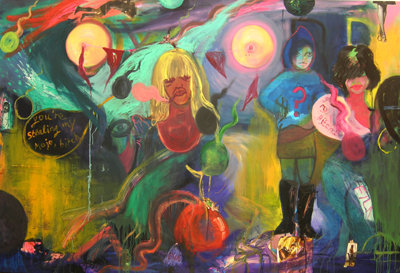Play Yourself
dal 11/7/2007 al 31/8/2007
Segnalato da
Mark Dean
Graham Dolphin
Seamus Harahan
Stefan Hirsig
Juneau Projects
David Moreno
Muzi Quawson
Lucy Stein
11/7/2007
Play Yourself
Gimpel Fils, London
The works in this exhibition explore the ability of music to not only express our identities, but also how music is central to the formation and maintenance of those identities. Works by: Mark Dean, Graham Dolphin, Seamus Harahan, Stefan Hirsig, Juneau Projects, David Moreno, Muzi Quawson, Lucy Stein.

Group show
Mark Dean, Graham Dolphin, Seamus Harahan, Stefan Hirsig,
Juneau Projects, David Moreno, Muzi Quawson, Lucy Stein
"Play Yourself", was the mantra of jazz musician Charles Mingus who
encouraged improvisation and a style of playing that would best express
the musician's personality and mood. The works in this exhibition
explore the ability of music to not only express our identities, but
also how music is central to the formation and maintenance of those
identities. "Play Yourself" is however an ambiguous phrase: at once
encouraging, it is also challenging. Play yourself: express yourself.
Play yourself: do it yourself. The variety of artworks included here
encompass the multiplicities of the phrase with fascinating results.
Song samples are repeated, remixed and replayed, to create new forms of
visual and aural representations in Mark Dean's multiple screen DVD.
"The Band" combines four unique performances and music genres to create
a band that doesn't exist in reality. Three musicians of varying degrees
of fame accompany fragments of their own previously-released material
while a group of school children sing a verse from A Midsummer's Night
Dream. The effect is magical and eerie as different generations use
music as personal expression to different ends.
The opening song to the Minutemen's LP "What makes a man start a fire"
is the bass heavy "Bob Dylan Wrote Propaganda Songs". Planned as a
tribute to Dylan it is also a parody of Dylan's early lyrical style.
This combination of affection and mimicry is echoed in Graham Dolphin's
use of the Minutemen's album cover and his compulsive transferal of the
cover design onto the vinyl disk itself. His work reminds us of the
importance of the album sleeve notes and imagery to our understanding
and appreciation of the music itself.
Seamus Harahan's film references the urban environment. Filming marginal
lives within Belfast city center, his work transforms the mundane into
something much more poetic. Combining imagery of stray dogs and homeless
men with an upbeat reggae soundtrack he suggests an alternative way of
viewing the world around us. Images of a bird in flight bathed in
dappled sunlight reminds us that cities have rhythms and soundtracks
that are unique and which influence our perceptions of where we live.
Stefan Hirsig utilizes a specific type of display system for his
painting and collage work. An outer frame encloses the inner structure,
creating a sensation that elements might break through the frame and
complete the design of another painting.
Colour, geometric pattern and imagery from 12 inch record covers are
combined to create a dynamic field of energy that replicates the
excitement and movement caused by pop music. Records by The Smiths and
New Order become channels through which Hirsig produces his own dynamic
means of covering and uncovering, dis-solving and fusing the world
around us.
Previous works by Juneau Projects have seen them destroy mobile phones,
computers, camcorders, dictaphones and cd walkmans in order to make
unexpected sounds and music. Juneau Projects will present a new
sculpture and digital prints that illustrate their on-going
investigations into the ambiguous relationship between nature and
technology. On the one hand exploring the centrality of music to teenage
identity, their work also points to how urban life is detrimentally
distanced from nature. They frequently use characters and images of
animals and birds to tell stories about how we think we feel about
nature in the 21st century.
Mellow vibes and music's role in meditation emanate from David Moreno's
watercolour paintings. Our perception of sound is directly related to
the physical and kinetic nature of both the sound source and the
mechanism within our ears. These works not only provide a visual
representation of the experience of listening to music in a physical
way, Moreno's use of colour also suggests how music influences mood and
atmosphere.
For Muzi Quawson a chance meeting in Manhattan led to the creation of a
body of work that combines the personal life story of a girl called
Amanda, with the town of Woodstock in Upstate New York and its musical
history. Quawson has photographed Amanda since 2002, charting the highs
and lows of her life as musician, mother, lover, against the backdrop of
a town that has become idealized in American popular history. How the
legacy of the Woodstock festival in 1969 encroaches into the lives of
its present day population becomes a fascinating component of a
compelling set of images.
Combining oil painting with collage, drawing and other materials such as
hair, make up or cigarette butts, Lucy Stein creates figurative
paintings and drawings depicting young women in chaotic and fantastic
landscapes. With a dual interest in anxiety driven existentialism and
the kitsch and provocative language of pop, Stein's images explore the
boundaries of 21st Century feminism. Taking inspiration from Courtney
Love, female identity is shown to be obsessive, contradictory and a lot
of fun
Image: Lucy Stein, A voyage around our hairy nipples 2006. Oil & collage on canvas 78 3/4 x 98 1/2in/200 x 260 cm
Private View Thursday 12 July, 6-9pm with performance by Juneau Projects at 7pm
Gimpel Fils
30 Davies Street - London
Gallery opening hours: Mon - Fri 10am - 5.30pm, Sat 11am - 4pm



